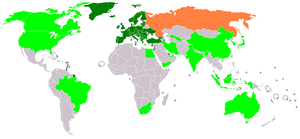ETSI

The European Telecommunications Standards Institute (ETSI) is an independent, not-for-profit, standardization organization in the telecommunications industry (equipment makers and network operators) in Europe, headquartered in Sophia-Antipolis, France, with worldwide projection. ETSI produces globally-applicable standards for Information and Communications Technologies (ICT), including fixed, mobile, radio, converged, broadcast and internet technologies.
ETSI was created by CEPT in 1988 and is officially recognized by the European Commission and the EFTA secretariat. Based in Sophia Antipolis (France), ETSI is officially responsible for standardization of Information and Communication Technologies (ICT) within Europe.
ETSI publishes between 2,000 and 2,500 standards every year. Since its establishment in 1988, it produced over 30,000. These include the standards that enable key global technologies such as GSM cell phone system, 3G, 4G, DECT, TETRA professional mobile radio system, and Short Range Device requirements including LPD radio, smart cards and many more standards success stories.
Significant ETSI technical committees and Industry Specification Groups (ISGs) include SmartM2M (for machine-to-machine communications), Intelligent Transport Systems, Network Functions Virtualisation, Cyber Security, Electronic Signatures and Infrastructures etc. ETSI inspired the creation of, and is a partner in, 3GPP and oneM2M. All technical committees, working and industry specification groups are accessible via the ETSI Portal
ETSI technology clusters[1] provide a simple, easy to grasp overview of ETSI’s activities in ICT standardization. Each technology cluster represents a major component of a global ICT architecture and covers the work of a number of ETSI technical committees and working groups that share a common technological scope and vision. The work of a single Technical Committee may be represented in several clusters. Clusters facilitate easy identification of an area of interest based on business relevance or application domain rather than purely on specific technical work areas.
In 2013, ETSI's budget exceeded €23 million, with contributions coming from members, commercial activities like sale of documents, plug-tests and fora hosting (i.e. the hosting of forums[2]), contract work and partner funding.[3]
ETSI is a founding partner organization of the Global Standards Collaboration initiative.
Membership
ETSI has over 800 members from 64 countries/provinces inside and outside Europe, including manufacturers, network operators, administrations, service providers, research bodies and users—in fact, all the key players in the ICT arena. Nearly a third of ETSI's members are Small and Medium Enterprises (SMEs). A list of current members can be found here.[4]
Current full members of ETSI are from all the EU member states[5]
Current associate members of ETSI are from Australia, Canada, USA, Brazil, South Africa, Lesotho, Egypt, Israel, Yemen, Qatar, UAE, Iran, Uzbekistan, People's Republic of China (together with separate memberships for its special administrative regions: Hong Kong and Macao), Taiwan, India, South Korea, Japan, Malaysia, Singapore, Indonesia.[5]
ETSI deliverable types
- European Standard, telecommunications series (EN): Used when the document is intended to meet needs specific to Europe and requires transposition into national standards, or when the drafting of the document is required under an EC/EFTA mandate.
- ETSI Standard (ES): Used when the document contains normative requirements and it is necessary to submit the document to the whole ETSI membership for approval.
- ETSI Guide (EG): Used when the document contains guidance on handling of technical standardization activities, it is submitted to the whole ETSI membership for approval.
- Special Report (SR): Used for various purposes, including giving public availability to information not produced within a technical committee. ETSI SRs are also used for "virtual" documents, e.g. documents that are dynamically generated by a query to a database via the web. An SR is published by the technical committee in which it was produced.
- ETSI Technical Specification (TS): Used when the document contains normative requirements and when short time-to-market, validation and maintenance are essential, it is approved by the technical committee that drafted it.
- ETSI Technical Report (TR): Used when the document contains mainly informative elements, it is approved by the technical committee that drafted it.
- ETSI Group Specification (GS): Used by Industry Specification Groups according to the decision making procedures defined in the group's Terms of Reference. This deliverable type is approved and adopted by the Industry Specification Group that drafted it.
This list is gathered from the European Telecommunications Standards Institute website.[6]
Ongoing Working groups
All technical committees, working and industry specification groups are accessible via the ETSI Portal
See also
- British Standards Institution
- CAdES
- Digital Enhanced Cordless Telecommunications
- Digital Subscriber System No. 1
- European Committee for Electrotechnical Standardization
- European Committee for Standardization
- HiperLAN
- HiperMAN
- Integrated Services Digital Network
- International Telecommunication Union
- KASUMI
- Open Mobile Alliance
- PAdES
- Project 25
- Single Wire Protocol
- TBR21
- XAdES
References
- ↑ technology clusters
- ↑ Forapolis. Etsi.org.
- ↑ "ETSI Annual Report". ETSI. Retrieved 1 February 2014.
- ↑ ETSI Membership Information. Portal.etsi.org - members
- 1 2 ETSI membership
- ↑ "Different types of ETSI standards". ETSI. Retrieved 1 February 2014.